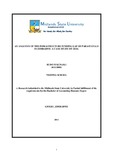Please use this identifier to cite or link to this item:
https://cris.library.msu.ac.zw//handle/11408/2318| Title: | An Analysis of the Infrastructure Funding Gap of Parastatals in Zimbabwe: a Case Study of ZESA | Authors: | Kunaka, Rudo M. | Keywords: | Infrastructure Funding Gap Parastatals Zimbabwe ZESA |
Issue Date: | 2014 | Publisher: | Midlands State University | Abstract: | This study sought to analyse the Infrastructure Funding Gap of Parastatals in Zimbabwe: A Case of the Zimbabwe Electricity Supply Authority. The research seeks to analyze the barriers to attracting investment, critically analyzing the effects of return on capital, poor debt management shown by the high debt to equity ratio and the tariffs as hindrance to the attainment of its goals and objectives. Literature review was used to conduct and informs the researcher of the influential researchers and research groups in the topic of electricity shortage and how it affects on productivity. Both case study method and descriptive survey design were utilized and latitudinal data was collected from a sample of 31 employees which consisted of 4 Executive managers, 8 operational managers and 19 non-managerial staff. The researcher used judgmental sampling method. Data was collected using questionnaires and interviews. 11questionnaires were distributed and all were completed which showed 100% response rate. The data was analysed and well presented on through tables, graphs and pie charts. The results indicated that infrastructure funding gaps were severe and a 100% response rate was recorded. Government is not injecting budget in parastatals to sustain its growth on infrastructure development. The results indicated that ZESA faces significant capital shortage and financing constraint, given the record of economic instability and poor credit-worthiness. Many infrastructure investments that are critical for economic recovery and poverty reduction would remain under-financed into the long-term. The research study recommended that the government should increase investments in electricity generation and should not concentrate on maintaining current power generation infrastructure but should explore building new infrastructure to increase its installed capacity and amount of power generated. ZESA Holdings should strictly adhere to load shedding schedules. ZESA Holdings should exclude manufacturing firms from load shedding at the expense of other consumers. Also recommended were strategies and policies to upgrade and modernize infrastructure, including possibilities of attracting investment. A further research finding was recommended to assess the infrastructure development of ZESA and strategies its investment attraction. | URI: | http://hdl.handle.net/11408/2318 |
| Appears in Collections: | Bachelor Of Commerce Accounting Honours Degree |
Files in This Item:
| File | Description | Size | Format | |
|---|---|---|---|---|
| Kunaka Rudo M..pdf | Full Text | 752.35 kB | Adobe PDF |  View/Open |
Page view(s)
112
checked on Dec 14, 2025
Download(s)
60
checked on Dec 14, 2025
Google ScholarTM
Check
Items in MSUIR are protected by copyright, with all rights reserved, unless otherwise indicated.



